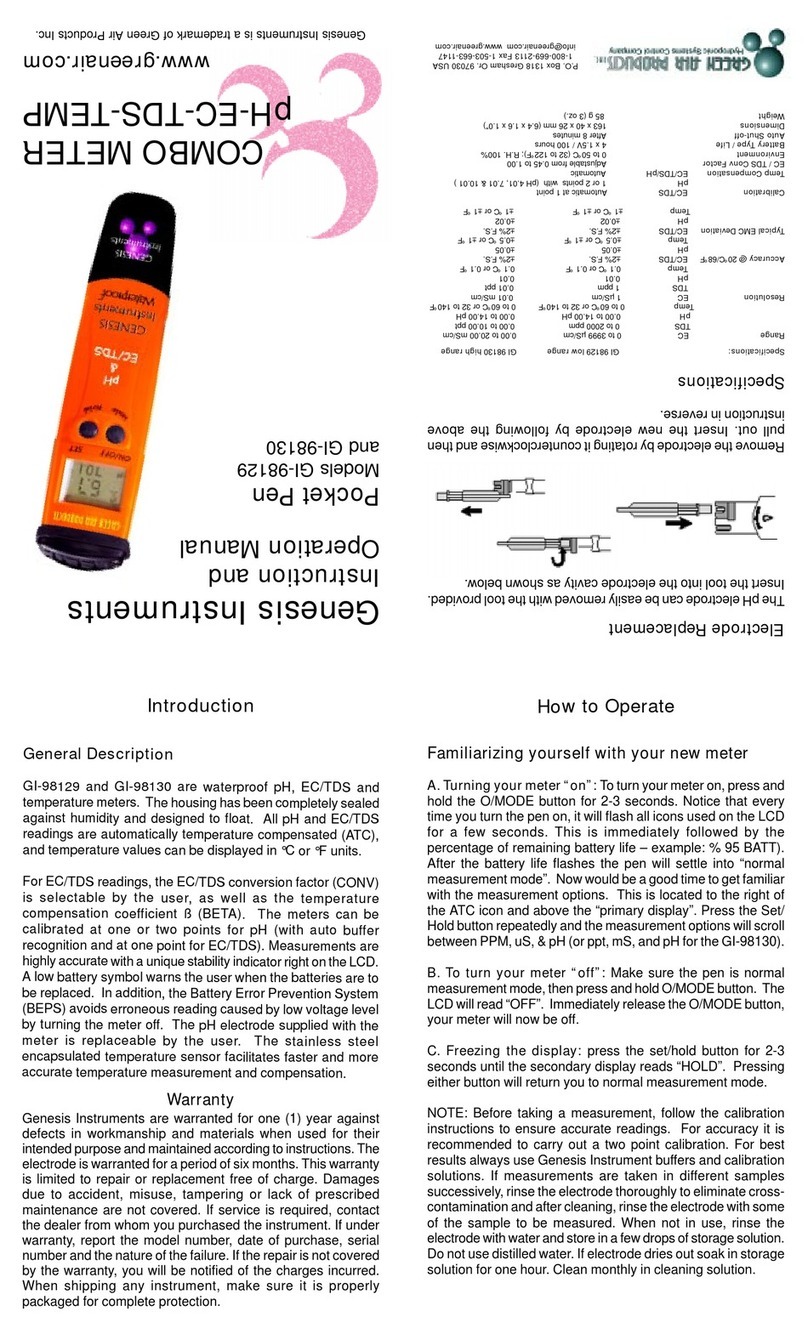
44-00-0297 SHERLOCK102/202 REV. 4.1 05-02-15 7
The American Society of Heating, Refrigeration, and Air-
Conditioning Engineers, Inc Standard ANSI/ASHRAE 15-
2004 Safety Code for Mechanical Refrigeration states:
8.11.2 Each machinery room shall contain a detector,
located in an area where refrigerant from a leak will
concentrate, which shall activate an alarm and mechan-
ical ventilation ....
The International Conference of Building Official Uniform
Mechanical Code, 2000 states:
SECTION 1121 - DETECTION AND ALARM
SYSTEM
1121.1 General. Alarm shall be activated whenever the
refrigerant vapor Permissible Exposure Limit (PEL)
is exceeded. In other than machinery rooms, such
systems shall also automatically stop the flow of
refrigerant to evaporators within the space and stop
the flow of refrigerant in all supply lines leaving the
machinery room whenever the refrigerant vapor con-
centration is detected at or above 50 percent of the
IDLH [Immediately Dangerous to Life or Health] or 25
percent of the LEL (lower explosive limit).
The SHERLOCK 102, and 202 Refrigerant Gas Monitor was
designed to meet these and other requirements.
Monitoring Panel
The SHERLOCK 102 and 202 Control Module is an ETL
listed, hard wired, permanently mounted electronic control
panel that is capable of monitoring the analog output signal
of up to two SHERLOCK Refrigerant Gas Sensors or one
SHERLOCK Refrigerant Gas Sensors and one SHERLOCK
Oxygen Depletion Sensors. The Control Module will activate
four Form C SPDT relay contacts based upon the programmed
alarm setpoints of each sensor. The relays are referred to as K1,
K2 for the first alarm level and K3, K4 for the second alarm
level. There is optional zone isolation alarm relay (K5 & K6)
for each Sensor. The Control Module can be located in the area
to be monitored, or in a separate location, typically outside of
the monitored room.
Monitoring Points
Each monitoring point consists of an analog signal generat-
ing sensor connected to the control module via discrete, three
conductor cable. Each sensor can be mounted up to 1000 feet
(longer run with special cable) away in locations where leaked
refrigerant is likely to concentrate.
THE SHERLOCK REFRIGERANT GAS MONITOR
The Sherlock gas sensors are available in three varieties:
Ceramic Metal Oxide Semiconductor (CMOS) or Solid
State Sensor
Non-Dispersive, Pyro-Electric Infrared Sensor.
Ammonia & Oxygen Depletion Electro-chemical Sensor.
CMOS or Solid State Sensor
The SHERLOCK CMOS (Solid State) Sensor utilizes a Tin
-Oxide filiment, heated to 400°F, to detect the presence of
oxygen molecules within the air. At this temperature, Oxygen
molecules cling to the filament. When a molecule of an organic
compound or a halogen strikes the filament, it displaces an oxy-
gen molecule thus increasing the resistive value of the filament.
This change in resistance is processed by the sensor circuitry
to produce an analog output signal, which sent to the Control
Module as the sensor reading.
Sensors are available in configurations that detect refrigerant
gases by class; CFC/HCFC, HFC and Ammonia. These sensors
produce a non-linear output signal that generally corresponds to
the concentration of refrigerant in the air.
NOTE: These sensors, due to their nature, are susceptible
to detection of non-refrigerant gases and cannot distinguish
the presence of different refrigerant gases, only that there is
a gas present. The CMOS sensor will detect high concen-
trations of gasoline, diesel, and propane exhaust and fumes
from solvents, paints, cleansers, and others (Please call
Genesis Customer Support for more information).
Infrared Sensor
The SHERLOCK Non-Dispersive, Pyro-Electric Infrared Sensor
utilizes a detection chamber with an infrared light emmiter and
an infrared Pyro-Electric photo sensor with a filtering lens. The
IR sensor will detect the presence of a certain gas by measur-
ing the change in the intensity of light measured by the photo
sensor. Each sensor is designed to detect only infrared light of
a specific wavelength corresponding to the refrigerant gas to
be monitored. This change in light intensity is processed by the
sensor circuitry to produce an analog output signal, which sent
to the Control Module as the sensor reading.
Sensors are available in specific configurations that detect cer-
tain refrigerant gases. Check with Genesis International for a
current list a available gas sensors.
These sensors produce a linear output signal that corresponds to
the concentration of refrigerant in the air. The Control Module
will translate the analog signal and display the readings in Parts
per Million values.
Electro-Chemical Ammonia Sensor
The SHERLOCK Electro-Chemical Ammonia Sensor utilizes
a chemical cell to determine the concentration of Ammonia in
the air. The chemical cell produces small chemical reaction
with Ammonia molecules, thus producing a voltage drop across
the cell. When the concentration of Ammonia goes up, the
voltage drop across the cell changes. This change in voltage is
INTRODUCTION
Genesis International
ETL Label P/N 44-0313
3.0 x 1.25 in
Shown is a Negative Image. Actual shall have
background black and lettering and logos white.
Label shall be suitable for weather conditions and cleansers..
3.00"
1.25"
ETL Label Plate
44-0313
10-30-02 Rev A.
ETL Listed
Conforms To UL Std. 3111-1
Certified To CAN/CSA
C22.2 Std. No. 1010.1
9800995
GENESIS INTERNATIONAL, INC.
1040 FOX CHASE INDUSTRIAL DRIVE
ARNOLD, MISSOURI 63010
PH. (636) 282-0011 FX. (636) 282-2722
44-00-0313
ETL Listed
Conforms To UL Std. 3111-1
Certified To CAN/CSA
C22.2 Std. No. 1010.1
9800995
GENESIS INTERNATIONAL, INC.
1040 FOX CHASE INDUSTRIAL DRIVE
ARNOLD, MISSOURI 63010
PH. (636) 282-0011 FX. (636) 282-2722
44-00-0313




























